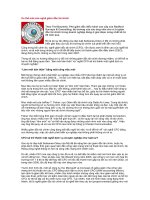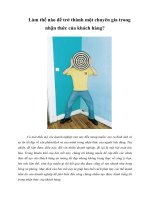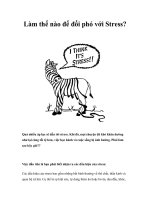Tài liệu Testing the Hearing Impaired Candidate doc
Bạn đang xem bản rút gọn của tài liệu. Xem và tải ngay bản đầy đủ của tài liệu tại đây (14.73 KB, 1 trang )
October 11, 1999
Updated: November 20, 2001
FILE MEMO
Subject: Testing the Visually Impaired Candidate
Our selection process affords people with disabilities the opportunity to request, and obtain, reasonable
accommodations in testing procedures. The principle in doing this is to ensure that test results accurately
reflect the aptitudes they are designed to measure, rather than candidates’ impaired skills. Procter &
Gamble’s recruiting organization has experience testing job candidates who are visually impaired in
varying degrees, including total blindness. The three basic options for handling a testing accommodation
for these individuals are:
1. enlarge the test by (a) printing on paper 2 - 3 times larger than normal, or (b) use special video
equipment that enables the candidate to enlarge whole pages or parts of pages;
2. read the test to the candidate; or
3. prepare a Braille version.
The Braille option is probably the least useful of these, especially for administering the PST. Many blind
people do not know Braille. Also, it does not really work with graphical information such as that
presented in charts on the PST. We have never tried this option because, as far as we are aware, no
candidate has ever asked for it.
We have used very large print copies with some partially sighted people. A few years back, we even gave
the test by reading it to a blind candidate. This requires following a very strict testing protocol to avoid
having the test administrator inadvertently provide unintended and unfair services to the test taker. For
this testing accommodation, the test administrator’s services should be limited to:
1. reading the test information and the questions aloud, and rereading parts as deemed necessary
by the test administrator or as requested by the candidate;
2. performing all calculator computations as directed by the candidate;
3. marking the answer chosen by the candidate on his/her answer sheet; and
4. video tape the entire session.
You may also want to give the candidate the option of bringing his/her own calculator. Visually impaired
people typically have special ones that they use.
Following the testing session, the answer sheet and video tape of the testing session should be analyzed
by a P&G recruiting manager to see how much time was spent on various parts of the test and how much
help was given by the test administrator. Using this information, and with assistance from Global
Recruiting if necessary, the recruiting manager should make a judgment as to whether the test score
produced is a fair representation of the candidate’s problem solving ability.
However, a serious visual impairment raises questions about what the job capability may be. Following
U.S. law, when we become aware of a disability that may need accommodation to enable the person to do
the job, or for which there may be no reasonable accommodation that would enable the person to do the
work effectively, we conduct an “Essential Functions Review.” Beginning with a description of critical
work elements for the particular job, we discuss with the candidate their perceived need for specific
accommodations and their potential effectiveness on the job when using them. The U.S. does this before
deciding whether to give a job offer.
.
Jennifer L. Irwin
Global
Recruiting









